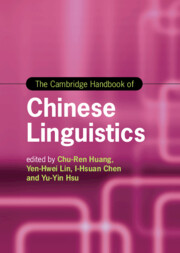Book contents
- The Cambridge Handbook of Chinese Linguistics
- Cambridge Handbooks In Language and Linguistics
- The Cambridge Handbook of Chinese Linguistics
- Copyright page
- Contents
- Figures
- Tables
- Contributors
- Acknowledgments
- Part One Writing System/Neuro-cognitive Processing of Chinese
- Part Two Morpho-lexical Issues in Chinese
- Part Three Phonetic-phonological Issues in Chinese
- 11 The Morphophonology of Chinese Affixation
- 12 Mandarin Chinese Syllable Structure and Phonological Similarity
- 13 Tonal Processes Defined as Articulatory-based Contextual Tonal Variation
- 14 Tonal Processes Defined as Tone Sandhi
- 15 Tonal Processes Conditioned by Morphosyntax
- 16 Tone and Intonation
- 17 Evidence for Stress and Metrical Structure in Chinese
- 18 Perceptual Normalization of Lexical Tones
- Part Four Syntax-semantics, Pragmatics, and Discourse Issues
- Index
- References
11 - The Morphophonology of Chinese Affixation
from Part Three - Phonetic-phonological Issues in Chinese
Published online by Cambridge University Press: 04 August 2022
- The Cambridge Handbook of Chinese Linguistics
- Cambridge Handbooks In Language and Linguistics
- The Cambridge Handbook of Chinese Linguistics
- Copyright page
- Contents
- Figures
- Tables
- Contributors
- Acknowledgments
- Part One Writing System/Neuro-cognitive Processing of Chinese
- Part Two Morpho-lexical Issues in Chinese
- Part Three Phonetic-phonological Issues in Chinese
- 11 The Morphophonology of Chinese Affixation
- 12 Mandarin Chinese Syllable Structure and Phonological Similarity
- 13 Tonal Processes Defined as Articulatory-based Contextual Tonal Variation
- 14 Tonal Processes Defined as Tone Sandhi
- 15 Tonal Processes Conditioned by Morphosyntax
- 16 Tone and Intonation
- 17 Evidence for Stress and Metrical Structure in Chinese
- 18 Perceptual Normalization of Lexical Tones
- Part Four Syntax-semantics, Pragmatics, and Discourse Issues
- Index
- References
Summary
This chapter synthesizes the alternation patterns in the morphophonology of Chinese affixation, and analyzes rime change (变韵 biànyuùn) mutation-like phenomena in terms of featural affixation. The main goal is to demonstrate that the paucity of affixation in Chinese languages/dialects does not render Chinese alternations less relevant to typological and theoretical pursuits. Two areas of morphophonology are examined to illustrate how phonetics/phonology interact with morphology under Chinese affixation: unexpected affixed outputs and the phonological realizations of featural affixes. Case studies of unexpected morphophonological outputs and unfaithful parsing of some root/affix features are reviewed, and the seemingly exceptional cases are explained by preservation of phonological/phonetic contrasts within the root-diminutive morphological paradigm and/or by morphological, prosodic and segmental principles and restrictions. An overview of the typology and characteristics of Chinese featural affixes is presented. The analytical approach rests on the theoretical underpinnings of non-linear phonology, the item-and-arrangement morphological model, and the notion of contrast preservation.
Keywords
- Type
- Chapter
- Information
- The Cambridge Handbook of Chinese Linguistics , pp. 223 - 244Publisher: Cambridge University PressPrint publication year: 2022



